What do you think of when someone mentions “goldfish?” The prize at a carnival, stuck in a plastic bag? Or perhaps feeder fish used to satisfy the diet of lizards, cichlids, and turtles?
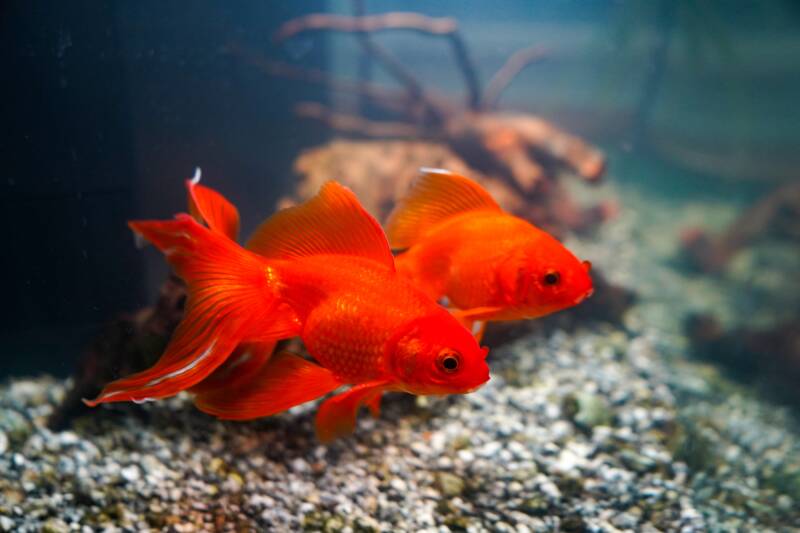
Surprise! Goldfish are so much more, providing colors and patterns aquarists prize.
Originating from the Siberian region of Asia, goldfish (Carassius aurutus) descend from the common carp. While you know their gold color, wild specimens wear colors of silver and dull bronze.
The gold and orange shades are strictly captive-bred – a mutation chosen by humans! Goldfish released into the wild revert to their natural colors. The bright shades wash out, and they resemble their wild-borne cousins.
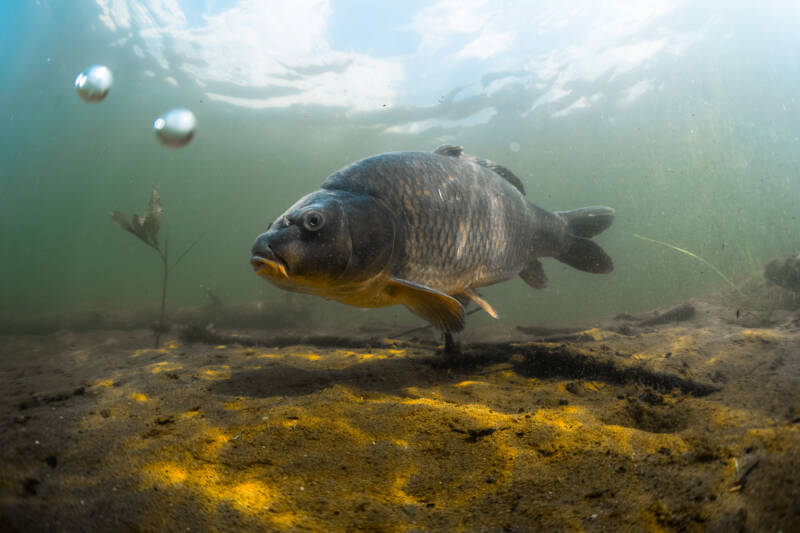
So if you come across an orange goldfish in a river, there’s a good chance someone turned it out of an aquarium.
[toc]
The Iconic Goldfish – Sorting Myth from Fact
Goldfish, in general, retain the sturdiness of their carp ancestors. As such, it shouldn’t come as a surprise to find they were the first aquatic animals to enter the pet trade!
Now aquarists have over 125 types of goldfish to choose from! However, their hardy reputation has prompted a few myths to sprout up over the years.
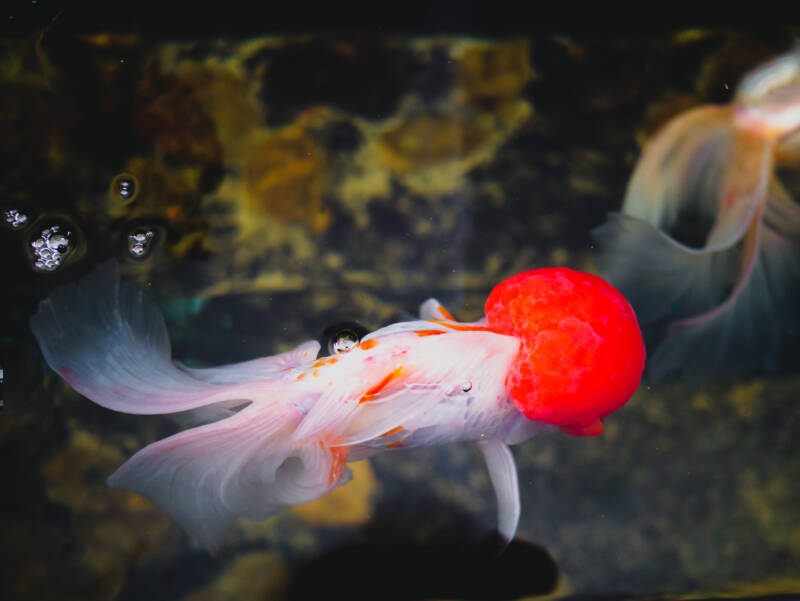
One of the biggest surrounds keeping goldfish in bowls. Supposedly, it’s not only safe to house a goldfish in a bowl, but it’ll also restrict the fish from growing.
There’s a TINY bit of logic behind this myth. In the wild, carp DO retard their growth when lakes dry up, or there’s overcrowding. The smaller size allows them to survive longer in harsh conditions. This in NO WAY translates to bowls and small tanks!
Stunted growth WILL happen, but it’s unhealthy. Goldfish are voracious eaters, and they produce a lot of waste. All of that waste quickly fouls the tiny bowl, resulting in illness and death. Proper tank or pond allows your goldfish to achieve a natural size.
With a nourishing diet and clean water, your goldfish will comfortably live 20 years or more. While you need a microscope to count them, goldfish lay down circuli or rings on their scales for every year they survive.
Mixing Goldfish Types
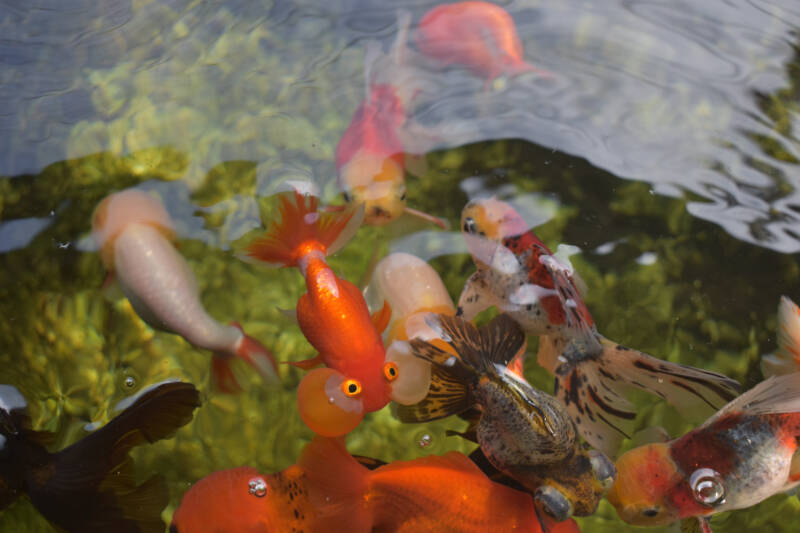
While it might be tempting to combine varieties of goldfish, don’t risk it.
Single-tail goldfish swim faster and better than fancy goldfish. Your poor fancies could end up starving as a result. (Not really fair)
At the same time, be careful about mixing certain types of fancy goldfish. If your fancies share delicate traits, they’re okay in the same aquarium. Combining hardy fancies with goldfish that are less sturdy is a recipe for disaster. Make sure you keep like with like.
Single-Tail Type Goldfish
You’ll never guess how the single-tail goldfish got their group name. (No one claimed biologists were original) Yup – they have one tail.
This group retains the most “original” appearance to the common carp ancestor.
The single-tails have slender, streamlined bodies free of ornamentation. That doesn’t translate to boring, though, as many received selective breeding for color variations or “showy” tails.
They’re active fish that appreciate plenty of open swimming room. Single-tail goldfish are hardy, tolerating a wide range of water temperatures.
They handle outdoor ponds or aquariums equally well. So long as you provide them with high-quality water, they’ll delight you with their swimming abilities.
1. Comet Goldfish

- Difficulty: Easy
- Temperament: Peaceful
- Diet: Omnivore
- Tank Size: 15 gal (57 l) for juvenile, 30 gal (113 l) for adult; add 15-20 gal (57-76 l) for each adult
Comets originated in the United States in the 1880s. They’ve retained their popularity among single-tail goldfish since then.
Their orange or yellow bodies terminate in trailing fins – the trait that distinguishes them from common goldfish. Similar to their name, comets are fast swimmers.
They do well in garden ponds, much better than they do in aquariums. If you do opt to keep them indoors in a tank, you’ll need at least 50 gallons (189 l) to provide enough space for a group.
If you’re looking for a goldfish with personality, comets are your best bet. These guys learn to recognize you at feeding time! Just be careful, as they can also become aggressive if you aren’t fast enough with the fish pellets.
2. Common Goldfish
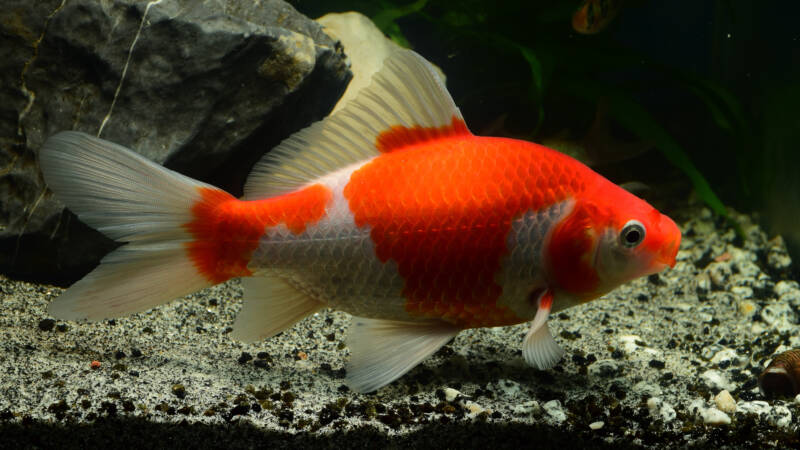
- Difficulty: Easy
- Temperament: Peaceful
- Diet: Omnivore
- Tank Size: 10 gal (38 l) for juvenile, 20 gal (76 l) for adult; add 10-15 gal (38-76 l) for each adult
As expected, the common goldfish meets the appearance people associate with the word “goldfish.”

Colors vary from golden yellow to deep red, and the more vibrant the color, the higher the value of the goldfish.
In an aquarium, commons top out around 6 inches (15 cm). In a pond, they can reach 10 inches (25 cm). The record for a common is a whopping 19 inches (48 cm) long!
As such, most aquarists feel commons should only reside in ponds – 200 gallons (757 l) for two goldfish.
Many people think goldfish have short memories, but commons remember information for up to three months. (So don’t mess up!)
And while you may think your fish are swimming tirelessly, they could be sleeping. Commons snooze with their eyes open!
3. Shubunkin Goldfish
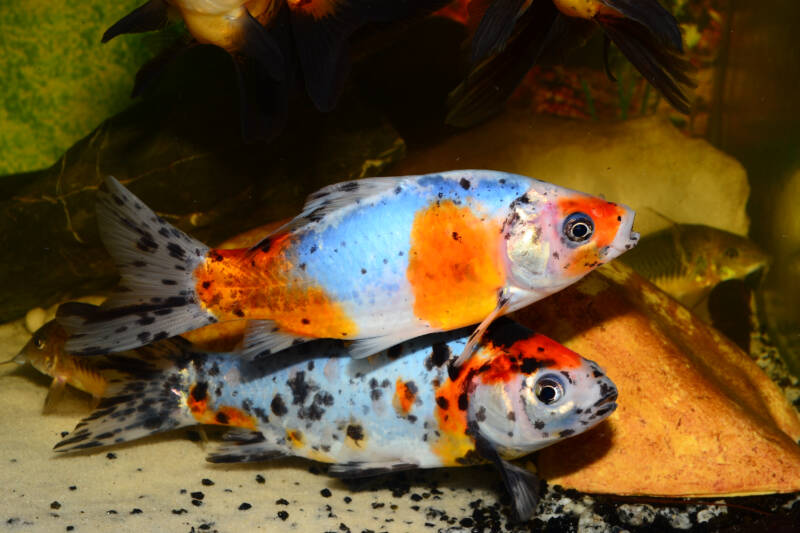
- Difficulty: Easy
- Temperament: Peaceful
- Diet: Omnivore
- Tank Size: 10 gal (38 l) for juvenile, 20 gal (76 l) for adult; add 10-15 gal (38-76 l) for each adult
Shubunkin goldfish sport distinctive calico patterns in orange, blue, white, and black. However, that isn’t why they’re special.
Nope, they earn distinction for that blue shade. Blue is extremely rare in goldfish, and Shubunkins carry the trait.
There are three sub-types of Shubunkin available: American, Bristol, and London.
Americans have long tails with deep indentations. Bristols have rounded, lobed tails that form the letter “B.” Londons feature shorter, rounder tails similar to commons.
Shubunkins tolerate wide temperature ranges, even for goldfish. They’re also hardy, though they can get picky about their food choices.
Oh, and make sure you plan your tank size accordingly because they can get up to 14 inches (35 cm) long!
Fancy Type Goldfish
Fancy types of goldfish appeared in Asia in the 19th century. Bred as ornamental fish, many of the varieties took on cultural significance throughout both the eastern and western worlds. You find fancy goldfish in artwork, and some featured in mythology.
Fancy goldfish have double tails, versus their single-tail cousins. They also have a rounded, stockier body.
With that body, they’re slow and often weak swimmers. (Some even lack a dorsal fin!) As such, they don’t compete well for food in a community aquarium.
Many of the fancy types feature delicate traits making them more difficult for aquarists to manage. While single-tail goldfish manage outdoor ponds fine, most fancies need indoor tanks where temperature ranges stay consistent.
4. Bubble Eye Goldfish

- Difficulty: Hard
- Temperament: Peaceful
- Diet: Omnivore
- Tank Size: 10 gal (38 l) for juvenile, 15-20 gal (57-76 l) for adult; add 10 gal (38 l) for each adult
Bubble eye goldfish are instantly recognizable. The variety originated in Asia, but the western world embraced them after World War II.
The water-filled sacs appear around six months, and they continue to grow with the fish. (By two years, they’re pretty significant!)
To say those bubbles are trouble is an understatement. You have to “bubble-proof” your aquarium.
No sharp edges, sponges over EVERY filter and intake, and NO aggressive tank mates. While a popped bubble isn’t the end of the world, it WILL invite infection.
Bubble eyes can’t see around those water sacs. They’re also not fast swimmers (let’s face it – they’re not aerodynamic). You can only group them with other peaceful, slow-swimming fancies if you want to prevent disaster.
5. Ryukin Goldfish
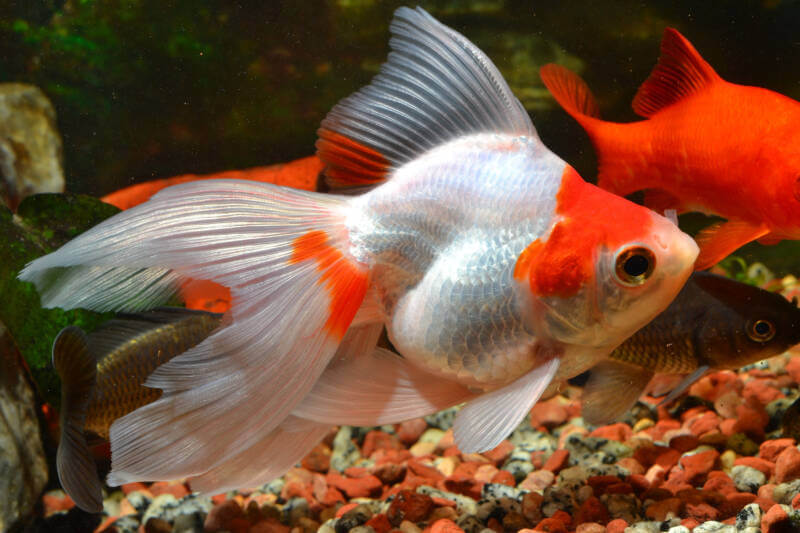
- Difficulty: Easy to Moderate
- Temperament: Semi-Aggressive
- Diet: Omnivore
- Tank Size: 10 gal (38 l) for juvenile, 20-30 gal (76-113 l) for adult; add 10-15 gal (38-57 l) for each adult
Ryukins resemble fantails as juveniles. No surprise there – fantails served as the origin for Ryukins.
Once they mature, your ryukin will develop the distinctive shoulder hump behind the head. These fancy goldfish are often taller than they are long.
That sturdy appearance translates to a hardy nature. While they shouldn’t share space with faster fantails, ryukins do just fine in garden ponds.
Just make sure you provide plenty of filtration because these fish create A LOT of waste!
If you want a prominent shoulder hump, focus on the food you offer. The more varied, and the better the quality, the larger that hump will grow. Watch your amounts, though, as ryukins can be a little aggressive toward other tank mates.
6. Fantail Goldfish
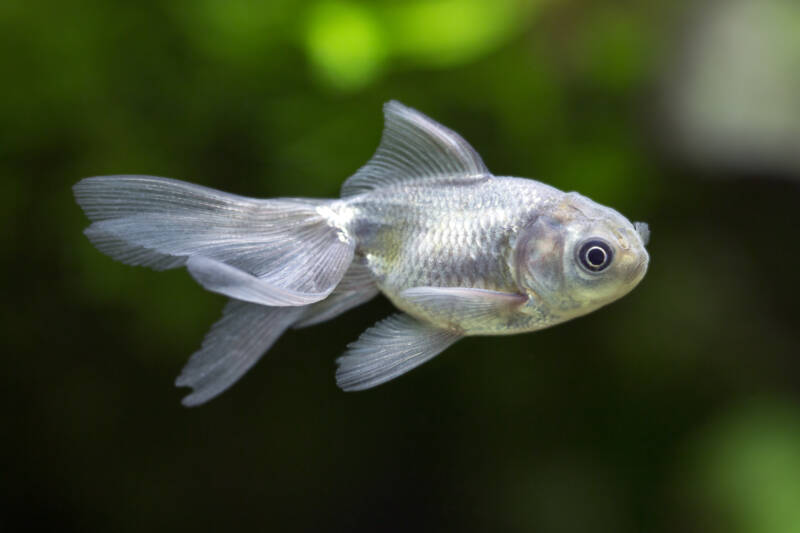
- Difficulty: Easy to Moderate
- Temperament: Peaceful
- Diet: Omnivore
- Tank Size: 10 gal (38 l) for juvenile, 15-20 gal (57-76 l) for adult; add 10 gal (38 l) for each adult
Fantails are the most single-tail like of the fancy type goldfish. They look similar to commons, but they have a quadruple flowing tail.
The tail results from the merging of their caudal and anal fins.
The fantails are the hardiest of the fancies. You CAN keep them in ponds without much trouble.
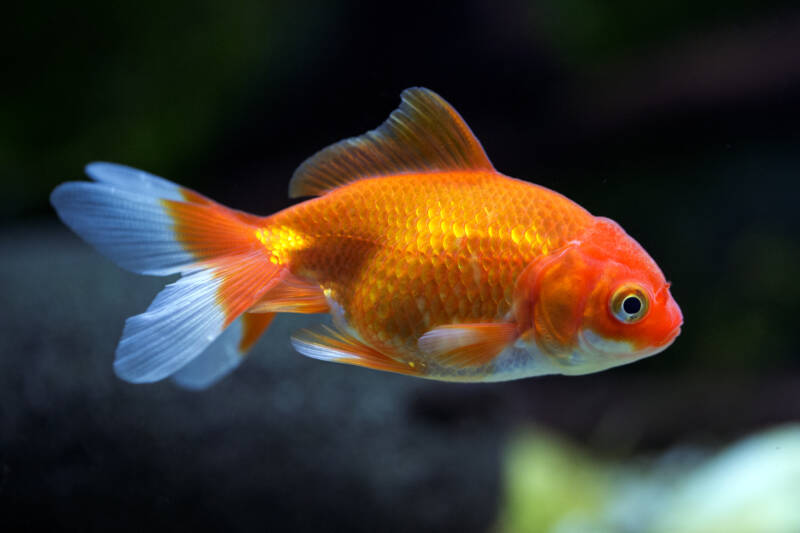
While they can’t outswim a single-tail, they’re faster than their fancy cousins.
The flowing tail conveys some agility, and they’re a treat to watch.
Fantails reach up to 12 inches (30 cm) in length. Aquarists often forget this, basing their tank size on the juveniles in the store.
With proper feeding of pellets, mixed with bloodworms, mosquito larva, and brine shrimp, your fantail will grow quickly!
7. Veiltail Goldfish
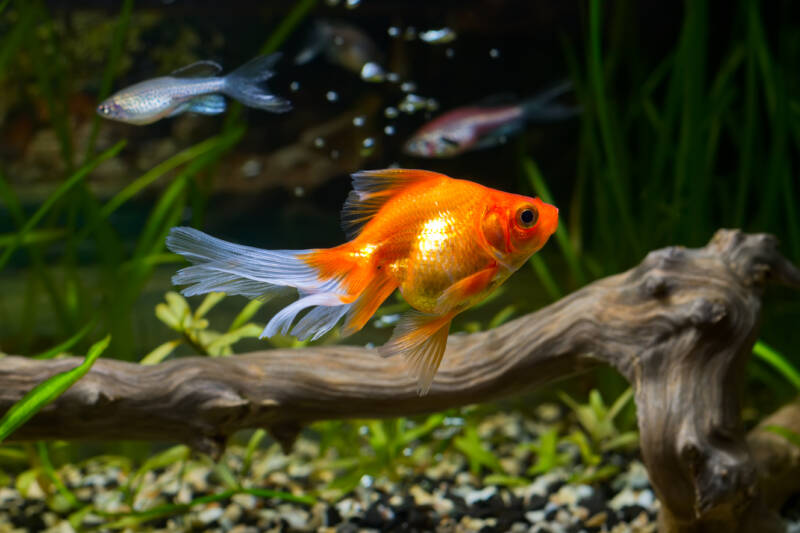
- Difficulty: Moderate to Hard
- Temperament: Peaceful
- Diet: Omnivore
- Tank Size: 10 gal (38 l) for juvenile, 20 gal (76 l) for adult; add 10 gal (38 l) for each adult
How do you tell a veiltail goldfish from a fantail?
You look at the body. Veiltails are broader and more compact. They also have an arched back you don’t see in the fantail. Set side-by-side, veiltails appear wider than their fantail cousins. (And they CAN share tank space)
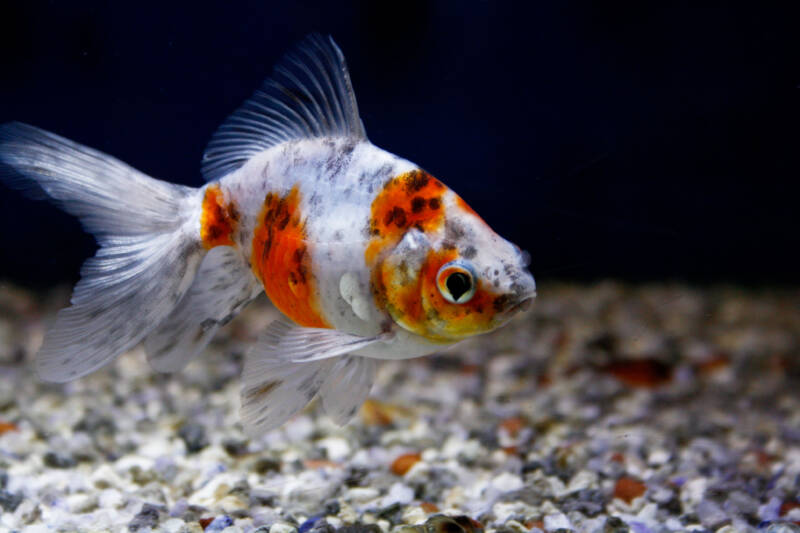
Of course, it’s those gorgeous, trailing fins that make veiltails so appealing. The tail’s twice as long as the body and split down the middle.
They also have a high dorsal fin. As they move through a tank, the fins provide a sweeping, graceful beauty. However, those fins provide a unique challenge. They’re DELICATE. It’s easy for them to catch or tear on décor within the tank.
And once they end up damaged, it takes no time for an infection to set in. You’ll want to go over all of the items in the aquarium with a fine-toothed comb.
8. Oranda Goldfish
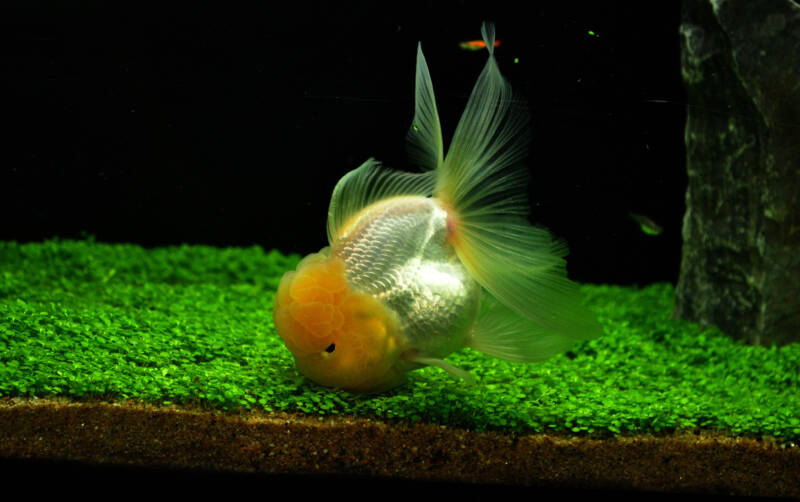
- Difficulty: Moderate to Hard
- Temperament: Peaceful
- Diet: Omnivore
- Tank Size: 10 gal (38 l) for juvenile, 15-20 gal (57-76 l) for adult; add 10 gal (38 l) for each adult
Oranda goldfish are some of the most popular fancy goldfish out there. The fleshy mass on the head, reminiscent of a lion’s mane, is referred to as a wen.
The wen appears around three months of age, and it tops out around 2-years-old. Wens grow throughout the life of the fish. They CAN grow excessively.
There’s no blood supply within the growth, and some aquarists trim them with clean scissors. (This ISN’T recommended unless you know what you’re doing)
Orandas get along well with other peaceful fancies. While the wen inhibits some of their swimming ability, they’re not as slow as other fancy goldfish. Provide them with a moderate water current, and they’ll stay happy.
9. Telescope Goldfish
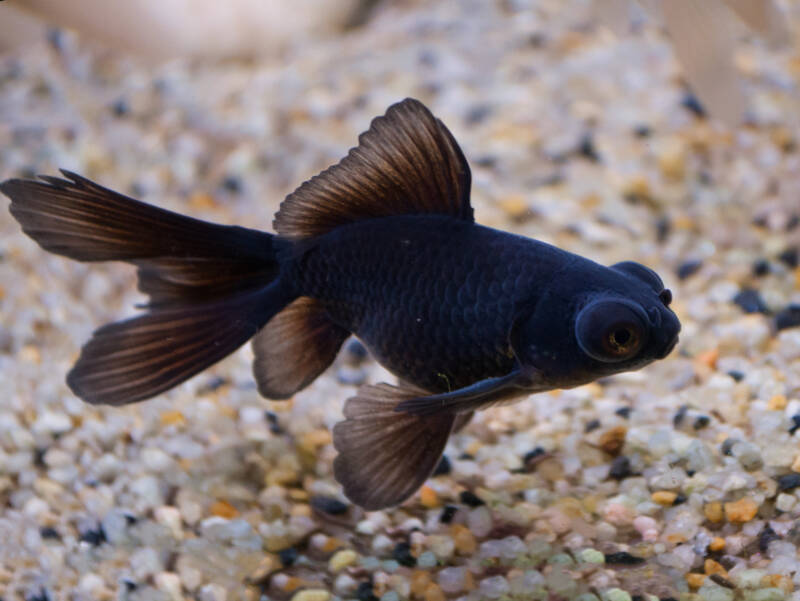
- Difficulty: Moderate to Hard
- Temperament: Peaceful
- Diet: Omnivore
- Tank Size: 10 gal (38 l) for juvenile, 15-20 gal (57-76 l) for adult; add 10 gal (38 l) for each adult
Telescope goldfish originated in China. You may see them referred to as demekin (their name in Japanese).
The wide, protruding eyes sit on stalks and can reach as far as 3/4 of an inch (1.9-2.0 cm). However, it takes about six months for the eyes to protrude fully.
Telescopes are NOT hardy fish. The eyestalks are delicate, and you need to take special care when cleaning the tank.
Cover filters with a sponge, and use a protector on your water change hose. Any damage to the eyestalk could result in infection or even loss of the eye!
Think the delicate nature of the eye is bad enough? Telescopes have poor vision! The location of the eye makes it hard for them to see.
They’re also not great swimmers. As such, these fish need a lot of TLC. Make sure you’re up to the job.
10. Wakin Goldfish

- Difficulty: Easy
- Temperament: Peaceful
- Diet: Omnivore
- Tank Size: 10 gal (38 l) for juvenile, 20 gal (76 l) for adult; add 10 gal (38 l) for each adult
Despite their simple appearance, wakin goldfish rank as one of the rarest breeds out in the goldfish world.
They share the shape of the common varieties, but they have a split, double-tail. It makes them fast and BAD choices to pair with other fancy goldfish.
Hardy by nature, you can keep wakins indoors or outdoors. They WILL decimate plants if you aren’t careful. You may want to choose plastic to prevent the need to make replacements.
And as long as you stay on top of water cleanliness, these fish can live up to 12 years. While one of the more sturdy fancy goldfish available, you still need to take care with your tank mate choices.
Bettas and cichlids make it a habit to harass wakin goldfish. And while wakins ARE fast, they’re not a match for these more aggressive fish.
11. Tosakin Goldfish
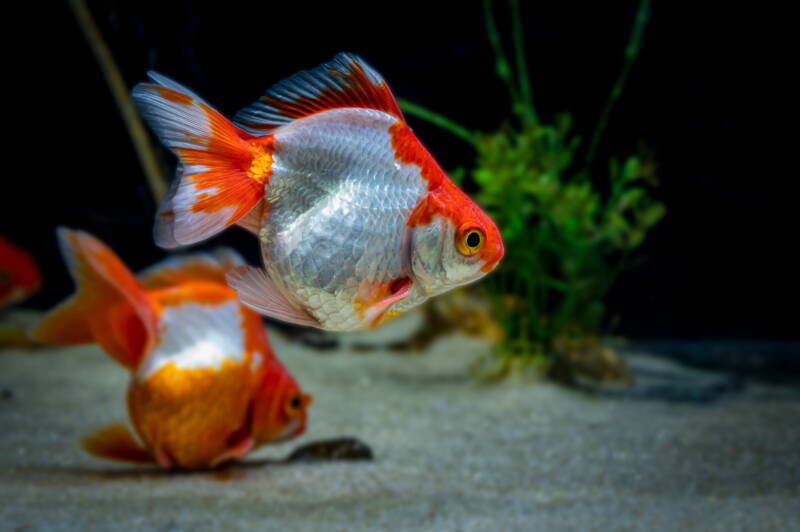
- Difficulty: Hard
- Temperament: Peaceful
- Diet: Omnivore
- Tank Size: 36-48 inches (91-122 cm) wide and 8 inches (20 cm) deep or less
Tosakin goldfish almost disappeared in the mid-1900s. In 1946, Japan went through an earthquake and an accompanying tsunami.
Shortly after, the heavy bombing of the Kochi Prefecture (the home of these goldfish) led most people to believe the fish lost forever.
Then Hiroe Tamura stumbled across six tosakins in a restaurant. He traded a bottle of sweet potato vodka to the owner and succeeded in reviving the line.
They’re now one of the rarest fancy goldfish aquarists hunt down. With undivided tails, tosakins get displayed in SHALLOW earthenware bowls. This allows for proper viewing – from ABOVE.
However, that means frequent water changes to keep up with the expected waste produced. You may want to go for a shallow, LONG tank instead.
12. Pearlscale Goldfish
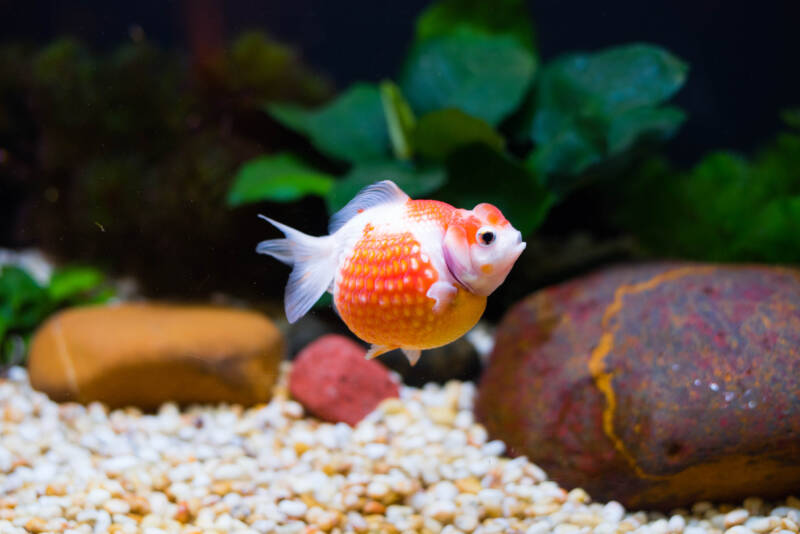
- Difficulty: Moderate
- Temperament: Peaceful
- Diet: Omnivore
- Tank Size: 10 gal (38 l) for juvenile, 15-20 gal (57-76 l) for adult; add 10 gal (38 l) for each adult
Pearlscale goldfish feature one of the strangest appearances among the fancy types of goldfish. Resembling an oddly colored golf ball, they have round bodies and prominent scales. The large scales catch the light beautifully.
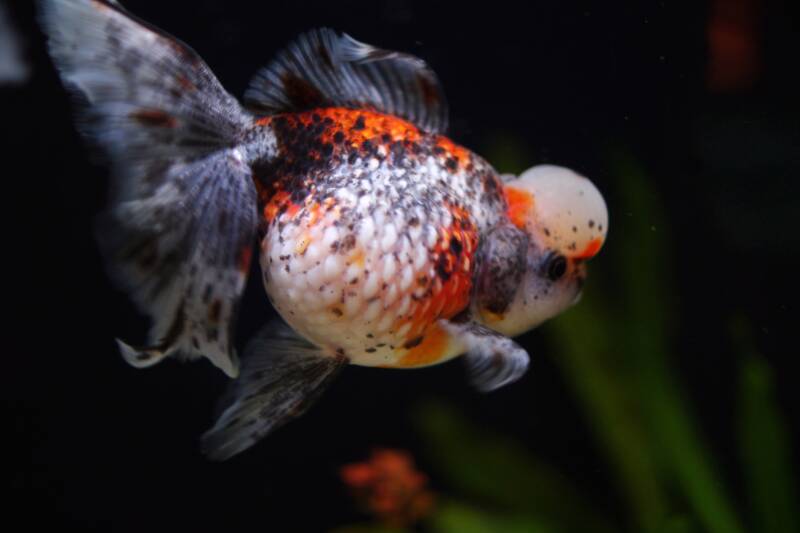
Unhappily, pearlscales aren’t good choices for beginning aquarists. Selective breeding achieved that appearance, resulting in the occasional failure of the swim bladder. Unfortunately, there’s nothing you can do to prevent this. Observe your pearlscales carefully.
You’ll need to keep pristine water conditions. Pearlscales fail the hardy goldfish stereotype. Again, selective breeding interfered with a lot of features in this particular fish. They look great, but they just don’t hold up well.
13. Pompom Goldfish
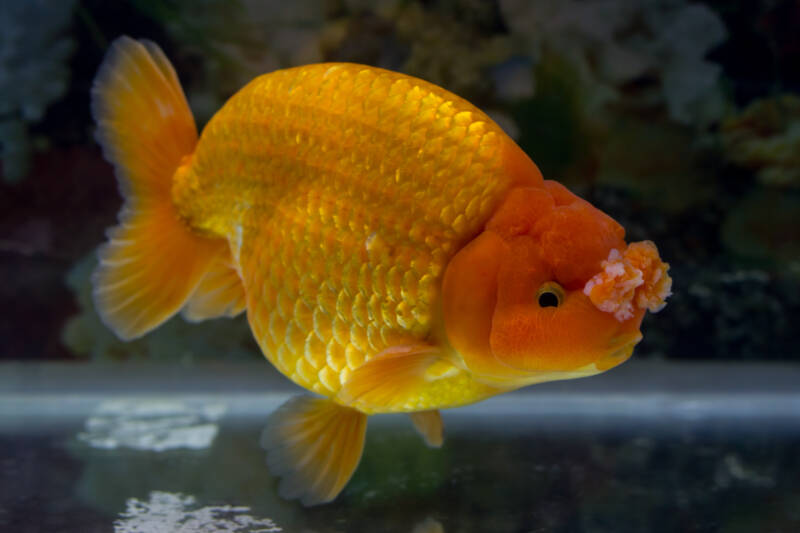
- Difficulty: Moderate
- Temperament: Peaceful
- Diet: Omnivore
- Tank Size: 10 gal (38 l) for juvenile, 20 gal (76 l) for adult; add 10 gal (38 l) for each adult
If you don’t mind an aquarium resembling a lava lamp, you might consider the pompom goldfish. With no dorsal fin and bouquets over their “noses,” these fancy goldfish are some of the slowest swimmers. But their speed isn’t what attracts aquarists.
Pompoms sport growths over their nasal septum. The growths differ from fish to fish, and they CAN obstruct the fish’s ability to see if they get out of control. They start to appear around 18-weeks of age, getting larger over several months.
Pompom goldfish aren’t suited for novice aquarists. Those bouquets are delicate. You’ll have to eliminate any sharp edges to your tank’s décor.
And you need to provide plenty of light. If you don’t, your fish will start to lose their bright colors (a distinct shame if you have the rare chocolate variety).
14. Lionhead Goldfish
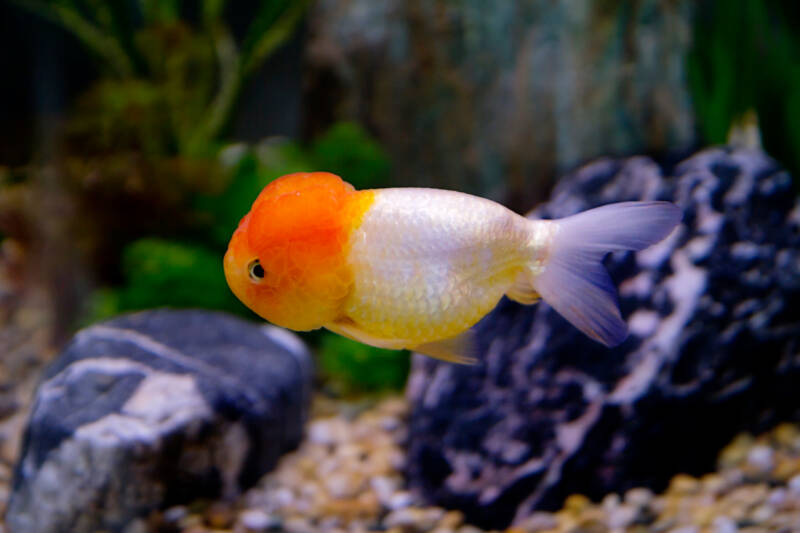
- Difficulty: Easy to Moderate
- Temperament: Peaceful
- Diet: Omnivore
- Tank Size: 10 gal (38 l) for juvenile, 20 gal (76 l) for adult; add 10 gal (38 l) for each adult
People occasionally mistake lionhead goldfish for orandas. Both feature a bumpy wen on their heads that remind aquarists of a lion’s mane. And they share the round shape of most fancy goldfish.
However, lionheads don’t have a dorsal fin – a critical difference. Lionheads have peaceful natures, partly due to their slow swimming speeds.
You won’t want to pair them with any tank mates that will outcompete them for food. Those double-tails (and double anal fins) don’t provide extra swimming power.
You need to take care of the wen of the lionhead goldfish. These regal fish still like to dig in the substrate, but the wen’s prone to injury and infection. You may need to consider keeping a bare-bottom tank to protect them.
15. Ranchu
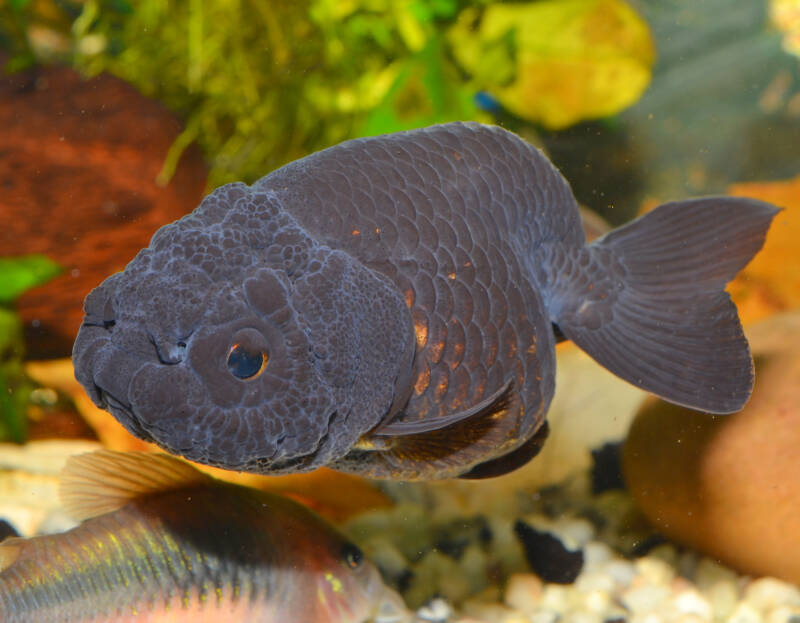
- Difficulty: Hard
- Temperament: Peaceful
- Diet: Omnivore
- Tank Size: 10 gal (38 l) for juvenile, 20 gal (76 l) for adult; add 5 gal (19 l) for each adult
With their smoothly arching backs, bubbly hoods, flared double tails, and lack of a dorsal fin, the ranchu goldfish is a prized sight. Indeed, these fish can range from household pet to show quality.
Ranchus reach an adult length between five to eight inches (13 to 20 cm).
Their body shape leads to slow swimming, and their hoods can impact their eyesight, which limits your choice of tank mates. They can live as a single specimen but fare better with a friend or two.
These fish are best for experienced aquarists. They are extremely sensitive to shifts in water parameters, especially rapid shifts in temperature.
16. Lionchu

- Difficulty: Hard
- Temperament: Peaceful
- Diet: Omnivore
- Tank Size: 10 gal (38 l) for juvenile, 20 gal (76 l) for adult; add 10 gal (38 l) for each adult
Another fish for the experienced aquarist, the lionchu is a cross between a ranchu and lionhead goldfish. This hybrid displays the preferred traits of the parent species, such as the ranchu’s arched, round body and the lionhead’s prominent hood.
They reach the same five-to-eight-inch length (13 to 20 cm) as do ranchus and come in a variety of colors and scale types.
These fish need clean, well-maintained water. They are sensitive to shifts in pH and ill-kept water can lead to infection of their hood.
Pair them only with slow swimming, peaceful fish that will not nip their fins or outcompete them for food.
17. Panda Moor Goldfish
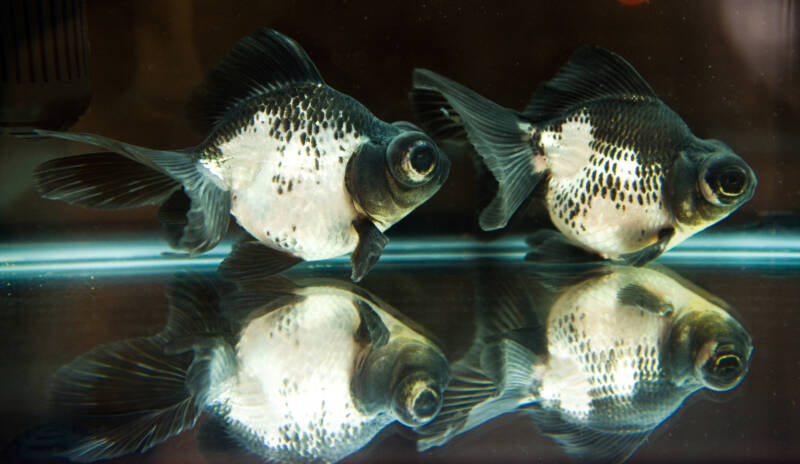
- Difficulty: Hard
- Temperament: Peaceful
- Diet: Omnivore
- Tank Size: 10 gal (38 l) for juvenile, 15-20 gal (57-76 l) for adult; add 10 gal (38 l) for each adult
Panda moor goldfish share similar needs to other moor telescope goldfish. Their eyes protrude from the sides of their heads, and they have a rounded shape.
Their claim to fame is the black and white color palette that reminds people of the panda bear.
Those colors don’t remain fixed, though. As juveniles, panda moors look bronze. And the older they get, the greater the chance they’ll change to another shade. You may even see them switch to a standard orange or gold.
Because panda moor goldfish have protruding eyes, they require aquarists with experience under their belt. You need to take care with your décor to prevent injury.
You’ll also want to pair them with tank mates that WON’T outcompete them for food and leave them starving.
18. Tamasaba
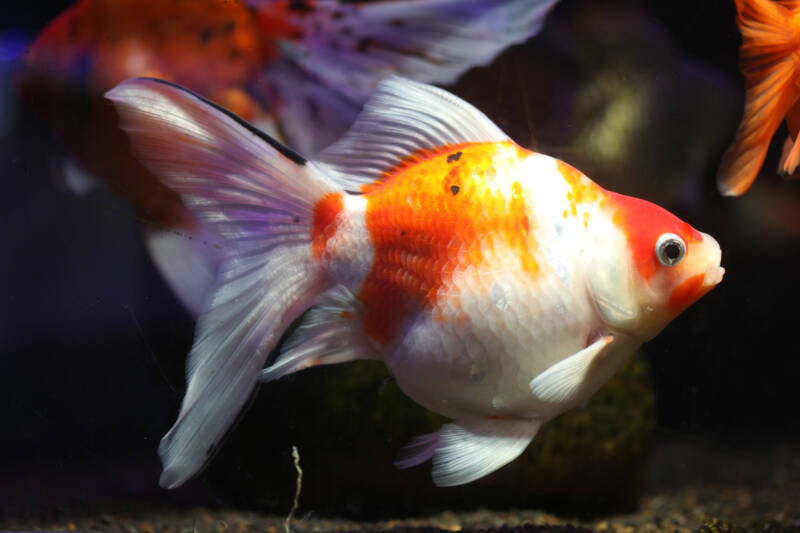
- Difficulty: Easy
- Temperament: Peaceful
- Diet: Omnivore
- Tank Size: 10 gal (38 l) for juvenile, 20 gal (76 l) for adult; add 10 gal (38 l) for each adult
The tamasaba has a gently curved back, rounded belly, and long, flowing fins. Their distinctive red and white color add to their appeal.
The tamasaba’s body shape may not produce the strongest swimmer, but it is far hardier and easier to care for than other species of fancy goldfish. They grow to a large adult size of 10 to 12 inches (25 to 30 cm).
Its enormous range of water temperature tolerance (50 to 82°F or 10 to 28°C) means that it can live in outdoor ponds as easily as within a home aquarium. Keep them with koi or other peaceful fish and avoid fast swimmers.
19. Nankin
- Difficulty: Hard
- Temperament: Peaceful
- Diet: Omnivore
- Tank Size: 10 gal (38 l) for juvenile, 20 gal (76 l) for adult; add 10 gal (38 l) for each adult
The nankin resembles the ranchu in its rounded, curved body shape and lack of dorsal fin. Their heads lack a large hood, and when viewed from above, they are triangle-shaped.
It can be challenging to find this red and white beauty, but the search is well worth it. These fish reach anywhere from eight to 8.5 inches (20 to 22 cm) in length and are active fish.
They can nibble on and dig up aquatic plants, so avoid keeping them in heavily planted aquariums. Keep an eye on the temperature and double filter your water as these are messy fish that are sensitive to rapid parameter shifts.
20. Celestial Eye Goldfish
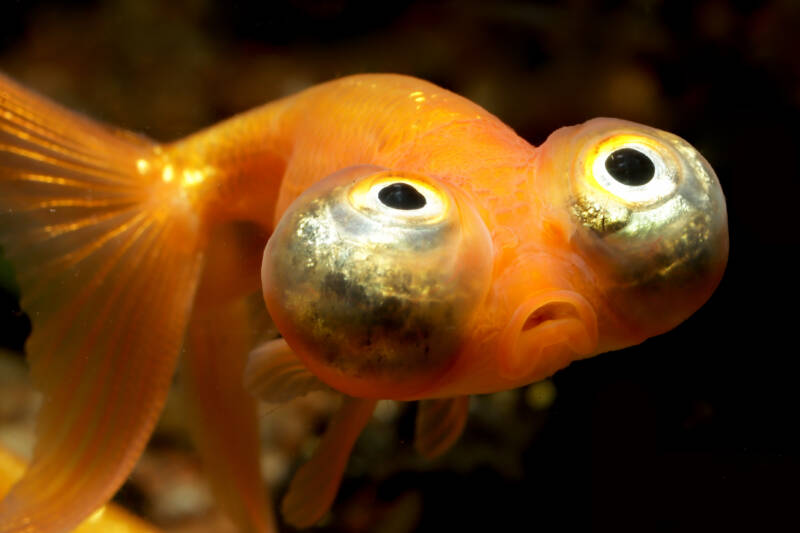
- Difficulty: Moderate
- Temperament: Peaceful
- Diet: Omnivore
- Tank Size: 10 gal (38 l) for juvenile, 15-20 gal (57-76 l) for adult; add 10 gal (38 l) for each adult
Also known as the stargazer, celestial eye goldfish take the telescope goldfish plan and mutate it further.
Their eyes stand out from the sides, but they also show a white ring and distinct pupil. It can look human-like compared to other fish species.
Unlike the telescope goldfish, which the stargazer came from, these tapered fish lack a dorsal fin. It makes them a slower species (and, of course, those eyes don’t make them streamlined). You’ll need to think through which tank mates you choose to pair them with.
Despite their poor visibility, celestial eye goldfish enjoy digging in the substrate like their cousins. You’ll want to make sure you provide a safe environment that protects their eyes. Otherwise, they may end up with damage that leads to infection.
21. Meteor Goldfish
- Difficulty: Hard
- Temperament: Peaceful
- Diet: Omnivore
- Tank Size: 10 gal (38 l) for juvenile, 20 gal (76 l) for adult; add 10 gal (38 l) for each adult
You’ll be hard-pressed to locate a meteor goldfish. It’s not a breed recognized by any of the goldfish societies. And breeders struggle to reproduce them consistently. More often than not, the label ends up assigned to fancy goldfish that resemble meteors.
Meteor goldfish have no tails or extremely small tails. Instead, they have strong anal fins and elongated pectoral fins that allow them to swim without a problem.
Their name comes from the silhouette that reminds people of a shooting comet. You can see the “meteor goldfish” pattern show up in other fancy goldfish.
But when breeders try to get the trait to breed through, the fry don’t usually survive, or they end up developing normal tails. As such, you’re not likely to come across a meteor without A LOT of searching.
Goldfish Tank Setup
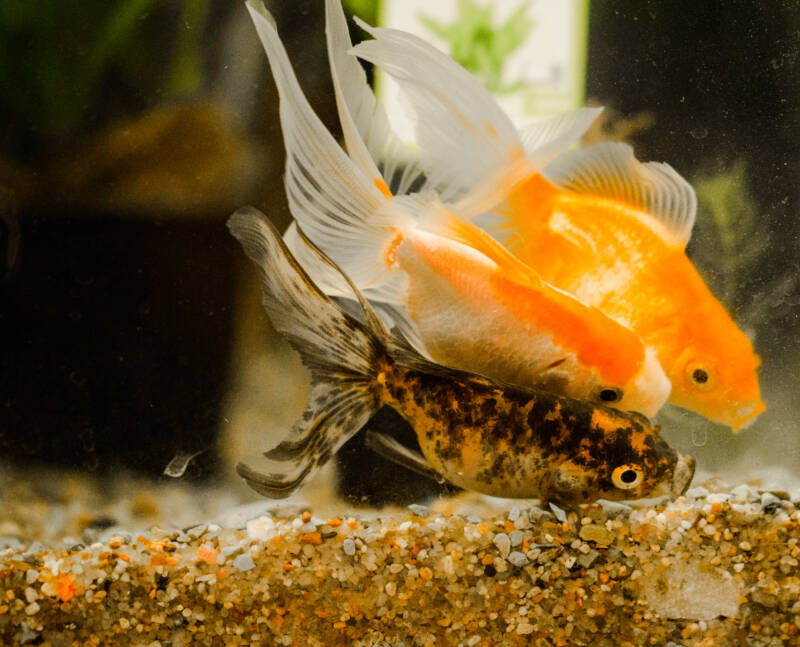
When you choose your goldfish, you’ll learn exactly how large a tank (or pond) you’ll need. (You’ll probably be surprised) The type of your goldfish will also determine the water conditions you’ll need to set up within your aquarium.
|
Parameter |
Single-Tail Goldfish |
Fancy Goldfish |
|
Temperature Ideal: |
55-80°F (12-26°C) 60-70°F (15-21°C) |
39-77°F (4-25°C) 68-74°F (20-23°C) |
|
pH |
6.0-7.5 |
6.0-8.0 |
|
Water hardness |
11.2-22.4 dH |
5-19 dH |
|
Water calcium |
70-140 ppm |
50-120 ppm |
|
Nitrites |
<0.2 ppm |
0 ppm |
|
Ammonia |
<0.1 ppm |
0 ppm |
|
Nitrates |
<50 ppm |
<50 ppm |
Insane ranges, right? Goldfish have incredible tolerances to water temperatures and acidity. They even tolerate stagnant waters, so long as the water is clean and free from impurities.
That gives you a lot of room to maneuver. (Still, aim to meet your goldfish type’s needs) Swift, running water doesn’t mix well with goldfish.
Some of the fancy goldfish, in particular, can’t handle currents. (Their delicate features don’t hold up against rough water) As such, you won’t need to go overboard with air stones.
Striking Gold
People are quick to dismiss goldfish as ordinary and boring. The truth is, they make great additions to both aquariums and garden pools.
Whether you favor the single-tail type or want the challenge of a fancy type, you’re sure to find a goldfish that appeals to you.
Which goldfish type is your favorite? Have you managed to keep pearlscale goldfish?
Let us know here!
